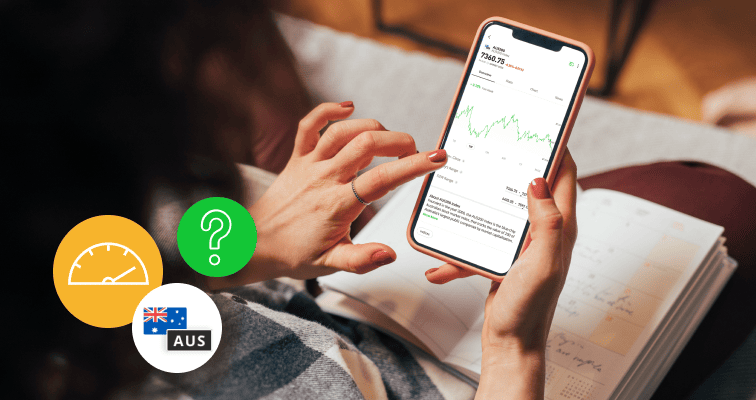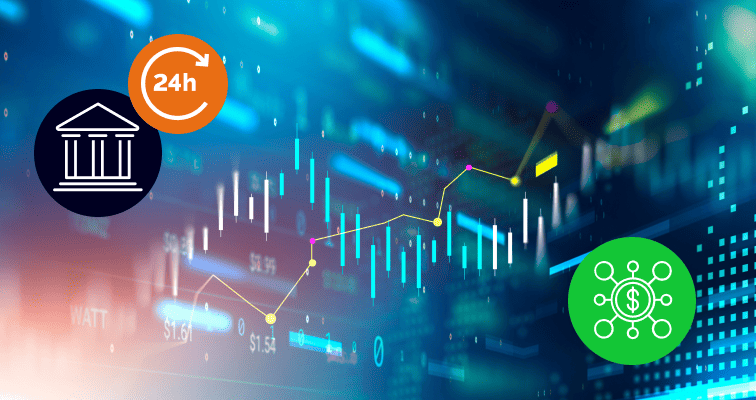Indices offer a way to gain exposure to the financial markets. Understand what indices trading is and learn about investing in key indices such as the S&P 500, FTSE 100 and the DAX 40. Discover what can impact the price of an index and some of the risks attached to trading them.
Indices offer investors the chance to track the performance of a group of assets, such as stocks, that are sorted by size, sector or other shared characteristics.
Watch the following video to learn more about trading indices.
What are indices?
Indices are financial instruments that track the performance of — and offer a way of obtaining exposure to — a group of assets, such as equities, in a single trade.
Different indices track different assets. For example, the ASX 200 Index is made up of the 200 largest firms listed on Australia Securities Exchange, whereas the FTSE China A50 Index is made up of stocks selected from the Shanghai Stock Exchange and the Shenzhen Stock Exchange.
Tip: Between January 2017 and January 2022, the SPDR S&P 500 ETF, which holds 500 mainstream US stocks, increased in value by 112%.

Why trade indices?
Gaining exposure to an entire economy or sector at once is one of the major benefits of trading indices. In a single trade, investors can take a position in a set of diversified stocks. For example, if you are looking to invest in US blue-chip stocks, but are potentially struggling to choose in which companies to invest, you could buy into the Dow Jones Industrial Average, an index fund that tracks the price of 30 household names, ranging from McDonald’s to JP Morgan.
Indices are also popular because they can be traded around the clock. This compares favourably to trading in individual stocks, which is often restricted to the opening times of your chosen exchange.
Indices can be traded 24/5 because they are available as a CFD (Contract for Difference). CFDs are leveraged products that enable you to scale up on risk-return, and provide the ability to sell short if you think the market is overpriced. When trading with leverage, you should remember that your profit or loss is calculated using the entire position size, not just the initial margin used to open it.
Tip: Indices are made up of a basket of assets, meaning you can use them to potentially reduce the risk of buying a single stock, significantly impacting the overall returns of your investment portfolio.

What indices can be traded?
High-profile, benchmark indices of the world’s leading stock exchanges are the most actively traded indices.
- S&P 500 Index: Tracks the stock performance of the 500 largest companies listed on stock exchanges in the US.
- FTSE 100 Index: Tracks the shares of the 100 largest companies listed on the London Stock Exchange. Informally known as the “Footsie.”
- Dax 40 Index: Contains 40 of the largest and most liquid German companies trading on the Frankfurt Exchange.
- NASDAQ 100 Index: Tracks the 100 largest and most actively traded US companies on the NASDAQ stock exchange. It is very tech stock heavy.
- Nikkei 225 Index: The benchmark index of the Tokyo Stock Exchange, containing stocks of the 225 firms with exposure to Asian markets.
Tip: ETFs (Exchange Traded Funds) provide a low-cost way to track and trade major indices.
What drives the price of indices?
The price of an index is determined by the value of the assets contained within it, such as individual stocks. If the price of those underlying assets rises, so will the value of the index.
Individual stocks will have some influence on the overall price of the index, but as capital is spread so widely across multiple positions, a major price move for one particular stock should not have a major impact on the overall value of the index.
Price moves in indices tend to fluctuate in line with broader investor sentiment. This comes down to judgements made on how higher-level factors, such as interest rates, inflation, employment levels and geopolitical events, might impact the economy or sector tracked by the index.
Investing in indices involves making a decision to track, rather than try to beat, the market.
How to start trading indices
To trade indices, you can open positions with CFD or ETF instruments. Once you’ve set up an account with a broker offering markets in these instruments, you can start buying and selling indices straight away.
As you get used to tracking the price of indices, you will notice that there are times of the day when the price tends to be more volatile. This volatility tends to be when the underlying market first opens or closes for the day.
Tip: Indices are a way for investors to diversify their portfolios.

Risks of trading indices
The primary risk associated with trading indices is if the market moves in the opposite direction to your initial prediction. This is an unavoidable risk of trading and is the reason that all investors should develop a comprehensive understanding of the assets they trade.
Trading CFDs using leverage can also result in losses that are greater than an investor is comfortable with. This can lead to emotional trading and additional mistakes being made.
Final thoughts
Investing in indices involves making a decision to track, rather than try to beat the market. There are no guarantees that picking individual stocks will result in greater returns than those of an index, and the passive investment approach of indices trading means less time is devoted to research and portfolio management. Alongside the opportunity to diversify, it is understandable that many investors make room for indices in their portfolios.
Head to the eToro Academy to learn more about investing in indices.
Quiz
FAQ
- Are indices a good investment for beginners?
-
Indices offer built-in diversification that helps to make them a good potential option for beginner investors. Diversification, in theory, helps to spread risk, smooth out returns and can enable investors to stick with their long-term strategy. On the other hand, indices are derivative products. They are complex instruments, and investors should consider whether they understand how this product works and whether they can afford the high risk of losing their money.
- Should I use leverage when trading indices?
-
Only the most experienced investors should consider using leverage when they first start trading indices. When trading a new market, investors should prioritise developing a better understanding of its characteristics. Using leverage can result in P&L swings that might distract investors from their long-term aims. Good brokers will allow you to set up your account to trade without leverage.
- Which index best tracks the performance of the overall stock market?
-
The S&P 500 Index is widely considered by investors and analysts to be the best guide for how the general stock markets are performing. While the stocks included are all listed on US exchanges, they tend to be large, multi-national firms such as Coca Cola, Microsoft and Exxon Mobil, most of which have a global client base.
This information is for educational purposes only and should not be taken as investment advice, personal recommendation, or an offer of, or solicitation to, buy or sell any financial instruments.
This material has been prepared without regard to any particular investment objectives or financial situation and has not been prepared in accordance with the legal and regulatory requirements to promote independent research. Not all of the financial instruments and services referred to are offered by eToro and any references to past performance of a financial instrument, index, or a packaged investment product are not, and should not be taken as, a reliable indicator of future results.
eToro makes no representation and assumes no liability as to the accuracy or completeness of the content of this guide. Make sure you understand the risks involved in trading before committing any capital. Never risk more than you are prepared to lose.


